Women and IMO Support
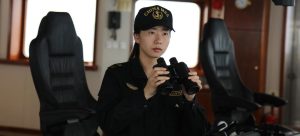 Credit UN News
Credit UN News
Maritime and shipping has historically been a male dominated industry . The International Maritime Organization (IMO) discovered that women represent only 1-2 % of the world’s 1.25 million seafarers and they mostly work in cruise ships. The mission of a merchant ship is to carry cargo from one port to another in a safe and efficient manner. A ship’s culture is a reflection of masculine norms and values. Seafarers invariably live and work in cramped ,mobile, isolated and residential workplaces for extended periods and encounter social and emotional isolation.
Women in Maritime and SDG’s
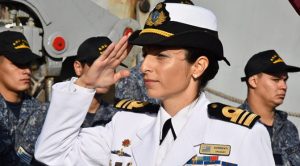 Credit CIMSEC
Credit CIMSEC
The IMO continues to support the participation of women in both shore-based and sea-going posts and advocates for its Member States to achieve the UN 2030 Agenda for Sustainable Development and particularly Goal 5 “Achieve gender equality and empower all women and girls”. IMO’s gender programme was initiated in 1988. At that time only a handful of maritime training institutes allowed women to enter their premises. Under IMO’s auspices eight Women in Maritime Associations (WIMAs) have been established in Africa, Arab States, Asia, the Caribbean, Latin America and the Pacific, covering some 152 countries and dependent territories and 490 participants.
Recent Advancements
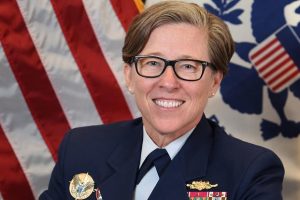 Credit Military.com
Credit Military.com
The U.S. Merchant Marine Academy’s superintendent is the first woman to be appointed to the position in the institution’s nearly 80-year history . Retired U.S. Coast Guard Rear Admiral Joanna Nunan is taking over the helm at the 1,000-person academy on New York’s Long Island .The institute had been the subject of lawsuits in matters of sexual harassment of female cadets.
Russia’s maritime sector pursues an orthodox policy and as far back in the year 2000 a decree was signed by President Vladimir Putin listing 456 jobs in 38 industries from which women were barred as that would entail “heavy work and work in harmful working conditions”. A breakthrough was achieved when an all-female Russian Navy crew carried out patrols in the Black Sea. Kidzhi is a Chief Mate on a Russian nuclear powered icebreaker ,comprising of 95 crew members ,and second to the Captain in Russia’s expanding nuclear icebreaker fleet owned by Rosatom, the state’s atomic energy corporation.
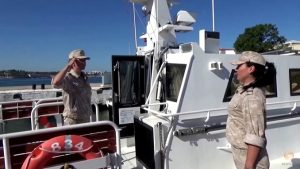 Credit Russia Business Today
Credit Russia Business Today
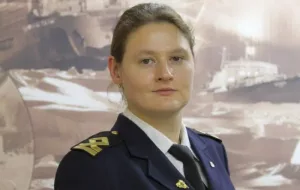 Credit Marine Insight
Credit Marine Insight
The nuclear power fleet is of strategic importance as Russia plans to use the Arctic Ocean and is building up its nuclear powered fleet for an alternate shipping route. The other nine women on the ship are not deployed on any operational posts.

Luisa Matias Senior Assessor, Visits and Inspections ,Human Element has been working in the European Maritime Safety Agency (EMSA) since 2005, as part of the operational tasks of the Agency, which implies inspecting Classification Societies. In her own words “ Every now and then I go to a shipyard or visit a ship. It is still a very male environment, but I see more women … I see that we are more visible! There are still barriers to be tackled and overcome. But the feeling of breaking barriers is extremely rewarding! “ . The number of female executives in the Danish shipping has not increased despite a focus on increasing diversity.
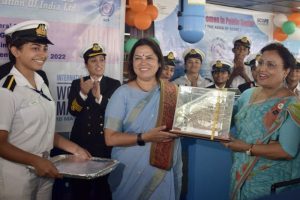 Credit Marine Insight
Credit Marine Insight
For the first time in India a cargo ship (MT Swarna Krishan) was commanded on a voyage by a woman captain and having only lady officers present.The UK has a long maritime history yet only 1% of engineer officers and 4% of deck officers are women and the female cadet intake miserably failed to move beyond 5% in each of the last three academic years.
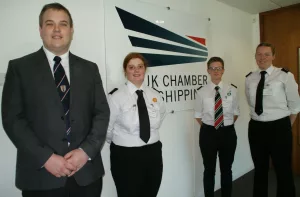 Credit Nautilus International
Credit Nautilus International
 Credit;Gov.UK Vanessa Blake
Credit;Gov.UK Vanessa Blake
In a heartening move for women adopting maritime as a career Vanessa Blake has been appointed as the new Chief Executive of the UK Hydrographic Office. Vanessa was the Interim Chief Executive since May 2024 and is now leading the UKHO on a permanent basis.The customers of the UK Hydrographic Office whether in defence or commercial shipping seek trusted advice, guidance and digital data support to safely navigate an increasingly complex maritime landscape and waterways.
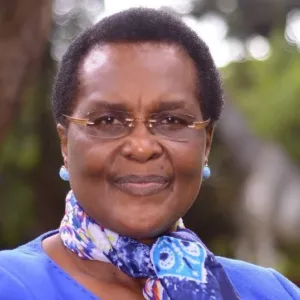 Credit;World Maritime University -Nancy W. Karigithu
Credit;World Maritime University -Nancy W. Karigithu
Mrs. Nancy W. Karigithu is currently the Principal Secretary, State Department for Shipping and Maritime in the Ministry of Transport, Infrastructure, Housing, Urban Development and Public Works and holds a master’s degree in International Maritime law from the IMO International Maritime Law Institute, Malta. She is on the Board of Governors of the World Maritime University , based in Malmo, Sweden. Mrs Nancy updated the legal framework for maritime activities in Kenya, business plans, annual operating budgets and advises the Government on maritime issues.
 Credit;Global Center for Maritime Decarbonisation – Prof Lynn Loo
Credit;Global Center for Maritime Decarbonisation – Prof Lynn Loo
Professor Lynn Loo CEO, Global Centre for Maritime Decarbonisation is the first CEO of the Center . She is technically proficient and shared that 60% of ships on the water today belong to owners that have 20 vessels or less in their fleet. These shipowners have different pain points than the global shipping players who are already adopting solutions considered “low hanging fruits” and are more concerned with technology maturity and price gaps. Professor Lynn Loo also shared that she got conducted a trial of two supply chains of sustainable biofuels to assist in resolving of issues of traceability and transparency. The consortium that did this trial ,under her supervision, managed this by adding a tracer in the biofuels at their production sites outside Singapore, and tracking the labelled biofuels to Singapore where they were blended and bunkered. Testing was also conducted until the biofuels were consumed onboard vessels. Tracking it across the supply chain supports development of an assurance framework on the quality, quantity and source of fuel, which allows the Global Centre for Maritime Decarbonisation to accurately account for the Green House Gas (GHG) emissions abated. She has the distinction of completing an ammonia bunkering safety study in partnership with DNV, Surbana Jurong and Singapore Maritime Academy. The study defines the safety and operational envelopes for an eventual bunkering pilot study to be conducted within Singapore’s port limits chosen as its population is less dense and around a thousand ships call at Singapore Port in a day, making the findings extendable to other ports around the world. A coarse quantitative risk assessment was carried out to figure out safety distances and a reasonable flow rate to pilot ammonia bunkering. The safety distances came up to be 300-400 metres based on a flow rate of 700 cubic meters per hour, close to parameters for LNG bunkering in Singapore when those operations first started.

Silvia Ding, the Chief Transformation Officer of A.P. Moller – Maersk, is the new President Maersk for the Greater China region. Silvia Ding launched an industry-transforming digitalisation strategy. As an Asian female, she has breached taboos to attain the highest executive position at the top of a global maritime business. She is a role model for other women in maritime and her mentorship has prompted women to follow in her wake.
Pakistan faces a dismal track record of no women nautical or engineering graduates. However in the Karachi Port Security Force a sizeable contingent of women is deployed for operational security duty , a first in the entire region.
 Credit marineinsight
Credit marineinsight
Captain Tahmasbi completed a three-month-long commanding course in 2023 and has a Master’s degree in computer science. She was an instructor of marine courses and advanced sea survival techniques. Captain Tahmasbi is Iran’s first female naval captain.
 Credit- WISTA TURKIYE – Melike Asyu GURGAN
Credit- WISTA TURKIYE – Melike Asyu GURGAN
Melike Aysu GURGAN is the Vice President of Turkiye Women’s International Shipping & Trading Association (WISTA) which is a global organization that connects female executives and decision-makers in the maritime, trading, and logistics sectors and boasts an international network of over 5,100 female professionals. She is a faculty member of Dokuz Eylul Maritime University and also Executive Committee Member of Turkish Shipbrokers Association . Melike Aysu GURGAN is the Founder and Managing Partner at Aqua Chartering .
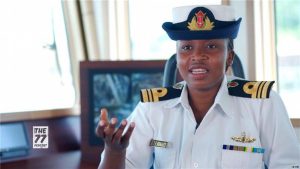 Credit DW
Credit DW
In Kenya Faith Mwagandi has the distinction of commanding a naval warship challenging gender stereotype roles in a conservative African country.
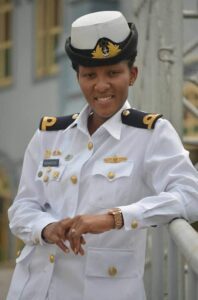 Credit ; Facebook – Lt Cdr Priscilla Ami Dogbeda Dzokoto
Credit ; Facebook – Lt Cdr Priscilla Ami Dogbeda Dzokoto
The first female Commanding Officer (CO) of a Ghana Navy Ship (GNS) – Lieutenant Commander (Lt Cdr) Priscilla Ami Dogbeda Dzokoto entered onto the command of an erstwhile male-dominated naval domain . She was born in 1986 in the Western Region of Ghana and studied at University of Ghana . Lieutenant Commander (Lt Cdr) Priscilla Ami Dogbeda Dzokoto is one of the first two females in the history of the Ghana Armed Forces (GAF) to be enlisted into the Executive Branch of the GN and has also received training at the Britannia Royal Naval College, Dartmouth in the United Kingdom in 2013.
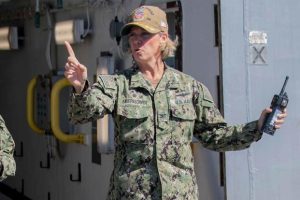 Credit Naval Post
Credit Naval Post
Capt. Amy Bauernschmidt became the first woman to command a nuclear carrier in the U.S. Navy. Capt. Amy has 3,000 flight hours to her credit and is considered a role model for women in the US Navy.She graduated from the Naval Academy in 1994 after the US Congress repealed the law barring female naval officers from commanding warships.
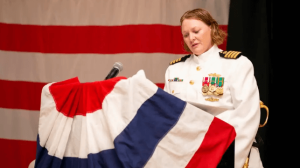
Credit ; The Maritime Executive
In a first the U.S. Navy’s Seabees Naval Construction Group has appointed a female commander, Captain Constance Solina , as commander of Naval Construction Group 2 based in Gulfport. Capt Constance is the first woman to command 4,500 Seabees on the Atlantic seaboard. Captain Constance Solina is from McLean, Virginia, and is a graduate of Purdue University.
 Credit;Shipping Watch-Georgia Fardellou
Credit;Shipping Watch-Georgia Fardellou
Georgia Fardellou is the head of ESG and corporate communications at Greek-based dry bulk shipping company Star Bulk. She had to struggle to reach the position of head of ESG of the dry bulk shipping company.
 Credit; lloyds List-Semiramis Paliou
Credit; lloyds List-Semiramis Paliou
Women of Greece are active in shipping . Semiramis Paliou serves as a Director of Diana Shipping Inc., and as Chairperson of the Board of Directors and of the Executive Committee of the Company and a member of the Sustainability Committee of Diana Shipping Inc.

The first female maritime cadet from Vanuatu is heading overseas as part of her cadetship program, celebrating a milestone for the island’s maritime sector. Jessica Ova will be serving on an international shipping liner . Her first port of embarkation is Saudi Arabia and she is contracted to train onboard a chemical tanker. Jessica Ova is a graduate of Ocean Logistics Maritime Academy.
By Nadir Mumtaz
Trademark Blue Economy IPO-PK


Leave A Comment